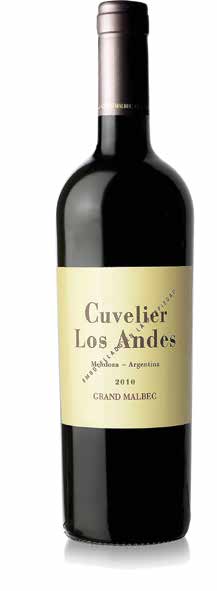By Monique Knill
As summer gives way to fall – ice hockey and football; the fall fashion look-book; the start of a new television season; and a comfort food offering of cassoulets, roasts, pizza and pasta accompanied by heartier, richer wine styles once again takes precedent on both the activity roster and local restaurant menus. Top of the list for trending wines this fall is Argentinean Malbec. With its appealing wine style catering to the modern wine drinker and its generally modest price point, its enduring international success comes as no surprise.
Malbec – a red grape originating from France – represents one of the big growth varietals this decade. Traditionally, Malbec was used in small amounts as a “seasoning” varietal in the great wines of Bordeaux to soften the more austere Cabernet grapes. While the grape still represents the backbone of many South West French wines, particularly in the Cahors region, Malbec is more commonly associated with the grape’s new world home of Argentina.
Argentinean Malbecs commercial success is a relatively recent phenomenon with producers historically catering to the needs of its large domestic market. Over the past five years however, producers have turned an eye to developing markets outside of Argentina, creating a boom for exports of Malbec and helping to raise the profile of Argentinian wines.
What makes Argentinean Malbec so unique? First, there are distinct differences between the Malbec clones grown in France and those in Argentina with Argentinean clones tending to have smaller berries. Next, Malbec is extremely sensitive to its environmental conditions. The level of ripeness grapes can attain has a profound effect on the wines final flavour and texture. By virtue of Argentina’s smaller berries, warm dry continental climate and perfect harvest conditions, Argentinean Malbecs tend to be richer, riper, and rounder compared to their more intensely dry, tannic, and meaty French counterparts. Furthermore, Argentina’s less marginal climate creates wines with remarkable consistency of style from year to year.
Introduced to Argentina as early as the 19th Century, Malbec is Argentina’s signature red grape representing over one third of total vineyard plantings.
The grapes true Argentinean lodging in is upper Mendoza where the Malbec grape dominates and excels. Mendoza, by far Argentina’s biggest wine producing region, is located in the most western part of the country across from Santiago, against the foothills of the Andes which form a natural border with Chile.

On the Left ALTOS LAS HORMIGAS MALBEC RESERVA VALLE DE UCO 2012: Uco Valley, a young sub-region of Mendoza, prized among winemakers for preserving Malbecs intense aromatics, lively acidity, and fresh, juicy black fruit character. This wine is well structured with fresh acidity and fine, silky tannins, and fruit forward demonstrating ripe, juicy, dark berry fruit complemented with spicy cassis, game and coffee notes, and a hint of minerality. Long savoury finish.
The regions’ vineyards tower above the valley floor in the less fertile Andean foothills at an altitude of up to 1200 metres, creating marked fluctuations in day and night temperatures. These extreme temperature variances help extend the growing season, enabling the grapes to develop full flavour complexity while simultaneously preserving their acidity. Mendoza also enforces Controlled Denomination of Origin (DOC) certification, which helps to protect the name of the region and obliges the regions producers to maintain specified quality standards.

On the left CUVELIER LOS ANDES GRAND MALBEC MENDOZA 2010: the Cuvelier family’s newest project. 100% Malbec wine produced from the Estate’s very best and concentrated Malbec parcels. This wine is impressively powerful and immolates the textbook Malbec style – deep purple in colour, firm finely grained tannins, bright acidity and concentrated and complex flavours of blueberry, plum, coffee, and chocolate. Long, rich, spicy finish. Worth the splurge!
Mendoza Malbecs are generally produced as either single varietal or Bordeaux blends with most wines seeing a period of oak ageing. Generally, this wine category represents great value with Mendoza Malbecs retailing in Canada from $10 for easy drinking quaffing wines to upwards of $50 for the upper echelon of renowned labels. The result: an affordable, signature style that has quickly garnered international acclaim.
With the category still relatively new, the interest lies within the regions development. Like many wine regions both blessed and hindered with notion of consistency of style, communications in the years to come are likely to add more weight towards differences in terroir. Mendoza is actually home to five unique geographical sub-regions including almost 900 vineyards with Gualtallary and Altamira representing some of Mendoza’s most exciting offerings due to the minerality their chalky soils impart to wines.
With exploration of smaller sub-regions and vineyard sites, we are likely to see both continued development of the top end of the market through the creation of high end wines, as well as winemakers unleashing their creative freedom with development of new styles – from lighter, fresher Malbecs with less oak influence through to dark, intense, complex ageworthy wines. Winemakers exploration of the notion of terroir coupled with Malbecs’ capability of expressing sense of place and greater experimentation gives the region enormous potential. With a bright future ahead, consumers can expect to be part of an exciting journey that for many has yet to extend beyond the enjoyable familiarity and typicity of Mendoza Malbec
